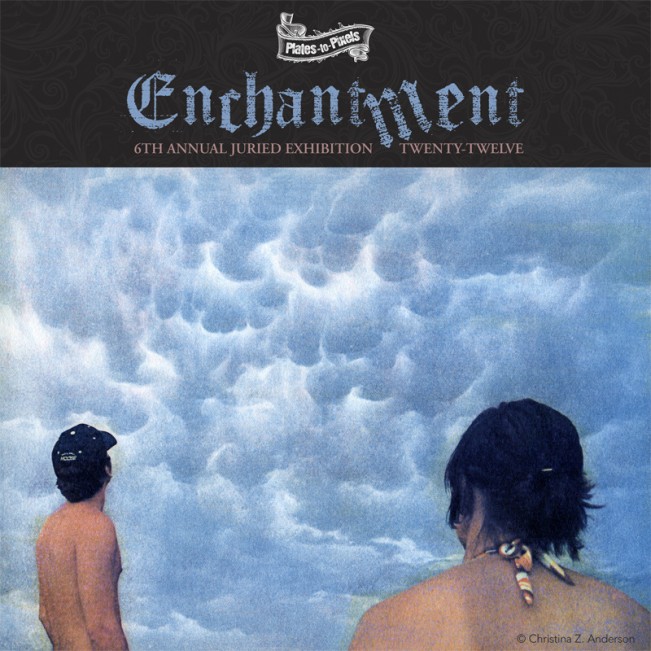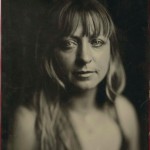The Blue Mitchell Mixtape
I’ve always viewed these projects as a marketing catalyst for photographers. I also feel the work I publish becomes a part of my personal art project as well… I take a small part of ownership in it, not publicaly, but in my psyche. I believe Diffusion and Plates to Pixels are art projects with many collaborators. So I guess you could say I’m looking for collaborators. –Blue Mitchell
I mentioned on Lenscratch sometime back that it is often the photographers we meet along the way that have the ability to change our lives, offer us opportunities, and see beyond our own potential. Once in a while we encounter a visionary that we find a bit more remarkable and special, who stretches beyond the limits of their own work and creates an outlet for OTHER photographers. Diffusion Magazine founder and editor, Blue Mitchell is one of those rare photographers. He’s all of the above and more…truly a dedicated photographer, father, friend, and someone that you want to be in the trenches with…(and he did serve in the Military!) Blue has focused his energies in celebrating work that is inventive and unusual and that doesn’t always fit the photography norms. He first created the online site, Plates to Pixels in 2006 and then established a print magazine, Diffusion Magazine, in 2009, both championing out-of-the-box thinking, unusual processes, and historical interpretations.
Besides being an independent publisher and a photographer, he is also a curator and educator. Based in Portland, Oregon, he received his BFA from Oregon College of Art & Craft where he teaches studio school classes and workshops. In his personal work he implements many photographic techniques including toy cameras, pinhole, alternative processes, mixed media, and hand drawing. Most recently Blue has been specializing in acrylic lifts – this process and some of his work was published in Photographic Possibilities, 3rd edition.
Blue manages to keep his feet on the ground, head in the sky of possibilities, and create platforms rich with inspiration and innovation. It gives me great pleasure to introduce The Blue Mitchell Mixape!
Tell us about your growing up and what brought you to photography.
I was born on the eastern plains of the northern tier of the United States, home of the Plains tribes the Sioux, Blackfeet and Crow. My birthplace was just northeast of the Little Big Horn battlefield. It was a lovely place to hunt for arrowheads, collect sage, and fish and raft the Yellowstone river.
When I was in the 1st grade, we took up residence in Paradise Valley, just outside of Livingston, Montana. That’s where my first memories were etched seeing my father photograph our breathtaking surroundings.
His camera fascinated me — it seemed like it had a 100 buttons, knobs, and interchangeable pieces. In reality, it was a simple 35mm SLR with just a few lenses and filters. Looking back, though, it seemed magical.
I didn’t really pick up a still camera until years later — outside of the proverbial disposable camera. What led to my first meaningful photography experience was my interest in film and video. That started in high school. Our school launched an elective course called “broadcasting.” I became the videographer and editor. We shot VHS and did all analog editing and spent many hours trying to make our broadcasts sound much more interesting than they were. Our broadcast came on the open circuit on Friday mornings. We covered school events, sports, news and random entertainment reports. It was horribly amateur and embarrassing but it was all we had. The YouTube generation of today would find the production appalling I’m sure. That experience, and others, would eventually lead me to film school at Montana State University (after a serving my country for a short time). I switched my major to photography my second year in…. the rest is history.
What is your title and job description and tell us about a typical day?
Hmmm, I carry several titles. And although diverse, they tend to relate and complement each other. By day, I am a full-time graphic designer for a healthcare organization. In the photography community, I am probably known more to Lenscratch readers as founder of Diffusion: Unconventional Photography, an annual publication. Personally, I typically just call myself an artist. That incorporates all of my titles into one: photographer, curator, designer, etc.
A typical week day is the standard 9-5 design job followed by family time and food. Then once everyone’s tucked into bed, I find myself working on my own artwork in the studio, curating projects, producing a new publication, or maybe prepping for an upcoming class I’ll teach. I spend a lot of time looking at art… lunch breaks, coffee breaks, etc. It never bores me to do so. Last year a made a little video for Kickstarter that was essentially a day in my life, check it out here.

2012 Catalog, for sale on site
How did the creation of Plates to Pixels come about, and then what got you into publishing Diffusion Magazine?
P2P was an idea I had brewing in college. I not only had a desire to do my own work but promote the work of others. At the time there weren’t a ton of online galleries using the brick and mortar model. I was certainly attracted to the idea of running a gallery but was a broke art student with no start up cash so I turned to the Internet to flex my curatorial muscle. More importantly though, I was interested in the dichotomy happening between digital work and analog (which now seems like an exhausted conversation). In the beginning I featured one digital artist and one analog or alt process photographer side by side. It wasn’t a rule, but more of a concept. When I first launched the gallery I went under the umbrella of a local photography organization to help it get some legs and legit support from an established business. Plates evolved quickly and became its own thing. At the same time I was finding the desire to do more in the real world with the connections and success of the gallery. This is how Diffusion was born. I wanted to make a real hard copy of the work I was doing for Plates. You could say the first issue of Diffusion was really just an experiment — a surprisingly successful one at that. We sold out of the first edition within two months of release. I was shocked, honored, and suddenly very very motivated to keep going with it. I was able to use volume I as a showpiece to woo artists and writers to come on board to help me with the project and, well, 5 years later here we are.
I should mention that when I started this print publication I knew nothing about producing and printing magazines or books so it was trial by fire. It helped that I’m also a graphic designer and could not only do the editorial and writing, but design as well. All of these things have improved with each issue. One of the biggest lessons I’ve had to learn is that it will never be perfect… but it can better… I can always do better. It’s important that the artists we feature get represented in the most elegant way possible. I feel very fortunate for all the support our photo community has given this niche project.
What are some of your proudest achievements?
Well it’s cliche, but I’ve been honored with an amazing daughter. Second to her, my other offspring — Diffusion — I’m quite proud of. Not just the publication, but the energy of it. It’s just mature enough to bring stuff home from its adventures that completely surprises me.
What do you look for when attending a portfolio review?
Reviews are a great way to see physical prints in person. Mostly, I look for a high level of craft, concept, and work that challenges me and inspires me. I’m also secretly looking for work that amuses me. I love humor in photography and there’s just not enough of it. I look for work that fits into the mold of Diffusion Annual and Plates to Pixels online gallery and often publish work I’ve seen at review sessions as well as curate shows around the work that really excites me. I’ve always viewed these projects as a marketing catalyst for photographers. I also feel the work I publish becomes a part of my personal art project as well… I take a small part of ownership in it, not publicaly, but in my psyche. I believe Diffusion and Plates to Pixels are art projects with many collaborators. So I guess you could say I’m looking for collaborators.

Portfolio Edition, for sale on Diffusionmag.com
Any advice for photographers coming to a review event?
You’ll hear this over and over again, but I truly feel that you can and will gain as much from your fellow photographers as you will from reviewers, and maybe even more. Spend time networking with your peers. It can lead to unknown opportunities. A pet peeve of mine is when an artist is not taking constructive criticism. Reviewers are going to have varying opinions and may give you contrasting viewpoints. Everyone has personal tastes and opinions. Be wary of defending (whether verbal or internal) your work to a point that you don’t listen to the reviewers’ advice or perspective. I can tell when your eyes glaze over as much as you can see the same in a reviewer. When you are finished with reviews, take the things away that you feel are the most important. Don’t let negative feedback get you down. Some ideas need to fleshed out better and some work needs to have better ideas implemented. Always take notes and research the references reviewers have given you. Most of them look at work ALL the time and have a good idea of what’s out there, what’s popular at the moment, and know ways to help your work stand out. Be nice, smile, and get plenty of sleep. Sadly, it goes without saying — do not expect to walk away with a bunch of opportunities right away. What you should expect is to enjoy yourself, enjoy your new mates, and never take anything too seriously, especially yourself.
What is something unexpected that we don’t know about you?
As a youth, I spent countless hours creating what I called “light sculptures,” but they were more like full-on installations. Most were devised from my fondness for creating environments with light and sound, rube goldberg machines, and formal composition. Looking back, I was not an electrician and probably created some massive fire hazards in my mother’s basement. Oh well, where’s the fun in art without some risk?
Since this is a Mixtape, what is your favorite song, band, and do you dance?
That’s a tough question for sure. I can tell you that Bloc Party is one of my favorite bands and they always get me dancing, unfortunately to their music, I dance like a total freak, as if I were in a flamboyant moshpit. Typically when these dance sessions spark up I am alone, or with my 3 year old. She’s thinks it’s hilarious and joins in. Here’s one of my favorite freakout dance songs: http://youtu.be/4Z3PkpxF5c0
And now, I hand over the post to Blue Mitchell:
I want to first off thank Aline for all she does for the photography community, it’s an honor to be a part of her Lenscratch Mixtape vision.
Now I’d like to briefly talk about some of the projects I’m working on. First off I want to point the lenscratch readers to a project I participated in a few years ago. I was invited to be a part of a collective of photographers and the one project that is still running after the group disbanded is the Shoe from Peru project. In a nutshell, a single shoe began traveling to photographers all over the world and became the subject of many photographs. I recently conducted a short question and answer with the photographer that found the shoe and set the project in motion. You can view the the whole interview, some of the photographs and travels at http://platestopixels.com/blog/claudia-luthi/
Secondly, I’d like to share our current call for lensless photography over at platestopixels. I have invited one of our first featured artists Zeb Andrews back as our juror. Some examples of the types of work we’re looking for are pinhole, lumen, zone plate, photograms, chemigrams, etc. We look forward to the many surprises you have in store for us! Entries due by October 28th. You can check out the prospectus here.
Lastly, the much anticipated Special Issue of Diffusion is now available for presale (Lenscratch readers are the first to know). This issue’s theme can be summed up as artworks derived from photography. It’s a pleasure to welcome George Slade as our guest writer. Mr. Slade’s historical knowledge, love of vanguard photography, and thoughts on the images showcased herein inspired him to convey, in words, what could be known as our ‘unconventional photography’ manifesto. Below are some of the award winning works you will find in the special issue.

Dark Mirror by KK DePaul

Saint Mark’s Square II by Danielle Dean Palmer

New Road by David Emitt Adams

Cabinet Cards on Artist Made Stands by Rachel Phillips

Parting From You Now by Rebecca Sexton Larson

Untitled by Clay Lipsky

Still Standing by Lauren Henkin

Grouping by Tobia Makover

Building and Rebuilding by Naomi Friend

Impression d’une Photographie by Greg Kemp

Muse by Athena Petra Tasiopoulos

Voyages en train 3 by A Nabarra Piomelli
Thank you Blue. We can’t wait to see what else you have up your sleeve!
Posts on Lenscratch may not be reproduced without the permission of the Lenscratch staff and the photographer.
Recommended
-
Ragne Kristine Sigmond: Portraits of Painterly LightDecember 2nd, 2025
-
Mary Pat Reeve: Illuminating the NightDecember 1st, 2025
-
Ricardo Miguel Hernández: When the memory turns to dust and Beyond PainNovember 28th, 2025
-
Pamela Landau Connolly: Columbus DriveNovember 26th, 2025
-
MATERNAL LEGACIES: OUR MOTHERS OURSELVES EXHIBITIONNovember 20th, 2025











































































